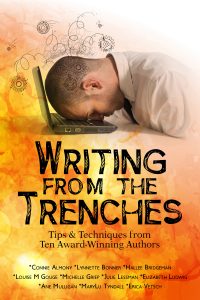by Hallee Bridgeman, @halleeb
In fiction storytelling, there are only three basic conflicts:
MAN VERSUS MAN: This is when a character is pitted against another character. Think Rocky, Star Wars, Cinderella. Some writing guides will tell you that there are five conflicts, and separate Man versus Man with Man versus Society and Man versus Self— but that is still Man versus Man, just with a plural antagonist or a singular antagonist. Basically, you have protagonist(s) versus antagonist(s), with both character motivations working against each other. Rocky’s antagonist was Apollo Creed. It was also himself — he had to work through some inner conflict. Star Wars on a broad scope was the Rebels against the Republic. On smaller scales, you had Obi Wan Kanobi against Darth Vadar and various other plots and conflicts. In Cinderella, we have Cinderella up against the wicked stepmother. This could also be considered CHARACTER VERSUS CHARACTER, because in science fiction stories, characters aren’t always human, but they still fall under this conflict.
MAN VERSUS NATURE/GOD: This is when a character battles against the forces of God and/or nature. Think Moby Dick, Master and Commander: The Far Side of the World, Six Below: Hero on the Mountain. In Moby Dick, Ishmael is battling against the whale (and, as a side conflict of man vs. man, he also battled against himself). Master and Commander, Jack Aubrey is battling against the raging sea. In 6 Degrees Below, Eric LeMarque is battling against the frigid temperatures while he’s lost on a mountain during a snowstorm.
MAN VERSUS TECHNOLOGY: Think The Terminator, iRobot,Outbreak. In The Terminator, we’re battling the machines of the future who have become sentient. In iRobot, again, we’re battling robots that have decided what’s best for humanity. Outbreak is a little harder to see as man versus technology – but medical advancements are considered technological advancements, and in that story, an airborne virus is killing people.
With three basic conflicts (or five if you separate Man Versus Man into three separate conflicts), we also have seven basic plots:
OVERCOMING THE MONSTER: Again, we’re going to look at Star Wars. In this example, the monster is Darth Vadar, and in a larger picture, the Republic. The characters must overcome the monster that is Darth Vadar, destroy the Death Star, and live to fight another day.
RAGS TO RICHES: The image that I use to explain this plot when I teach the class is the king placing a crown on Cinderella’s head at the end of the Disney movie. I think there’s even a couple of movies with the title Rags to Riches.
THE QUEST: Quest is defined as the long and arduous search for something. Indiana Jones immediately comes to mind when talking about quest stories. Another great one would be National Treasure.
VOYAGE AND RETURN: Think Wizard of Oz. In a good voyage and return, the protagonist is drastically changed during the process of the voyage.
REBIRTH: The best example of this that I can think of is A Christmas Carol. By the end of the book, Ebenezer Scrooge is radically changed, reborn if you will.
COMEDY: There are so many great examples of comedy. My kids just recently belly laughed their way through Daddy Daycare. One of my husband’s favorite comedies is Uncle Buck. My personal taste runs more toward Raising Arizona, but I tend to be weird with comedy.
TRAGEDY: Immediately coming to mind is The Fault in Our Stars. My daughter was reading that on her Kindle during lunch at school one day at the height of the popularity of the book. She was sobbing and sniffling but couldn’t stop reading. A friend walked by and glanced at her (unable to see the book because it was a Kindle and not a paperback) and asked, “Fault in our Stars?”
Some stories have multiple conflicts and more than one basic plot. That’s completely fine. Look at just the examples, and you can see how you can see different plot categories and more than one conflict. That’s okay.
So, with only three (or five) basic conflicts and seven basic plots, how can you take your “Once upon a time, this happened, then this happened, then this happened, and they all lived happily ever after,” and breathe life into it so that it pulls away from the herd and becomes a reader favorite?
Have you ever read a book that had you crying the way my daughter did when she read The Fault In Our Stars? Have you ever gasped with surprise when something happened in a suspense novel? Has your own heart swelled with love when the hero goes to one knee to profess his undying love for the heroine? What causes this kind of reaction or emotion from the reader? It can’t be the plot – there’s only so many plots out there.
“The characters are so true to life.” ~quote from a review of one of my books
In my experience as an author, one of the things that sets my books apart from all the other books out there is really good characterization. Over and over throughout my reviews and letters I receive from readers, my realistic characters are brought up. So often, I hear from a reader who was thinking about how my characters are doing right now before she remembers that they’re fictional characters and not really doing anything at all right now. Recently, I had a reader tell me that she found herself thinking about the circumstances one of my main characters was in and got so very angry at the protagonist — away from reading the book; just thinking about it while doing another task.
“This series is very honest. The characters are real and don’t make you feel like you are less than. The topics covered in the series cause you to look deeply into your own personal life and send you straight to the Father to have a one on one conversation with Him. Makes you deal with the issues we sometimes bury deep in our souls..” ~quote from a review of one of my books
The thing is, readers want to know your characters. They want to connect with them, to find a way to relate to them. They want to feel their pain and their joy and their love. It’s why readers read. The plots are important, but really only in a way that it creates the circumstances around which the reader connects with the characters.
What does good characterization mean? We’ll discuss that in part 2.
YOU … and an Army of Ten!
TEN-HUT! Gear up for your writing with tried-and-true tips from the trenches. Ten award-winning authors share invaluable tips and secrets they’ve gleaned the hard way, offering a broad range of insights and opinions on the best way to tackle subjects such as the following:
- Plotting Techniques
- Research
- Characterization
- Villains We Love to Hate
- Dynamic Dialogue
- Sigh-Worthy Heroes
- The Right Heroine for the Job
- Hooking Your Reader in the First Chapter
- Scene Endings to Lead Your Readers
- On Creating a Movie Set
- Making your Readers Cry
- Deep POV
- Copyediting your Manuscript
- Indie Publishing vs. Traditional
- Publishing Marketing for Those Who Hate Marketing
At last … a writer’s tool that provides the experience and expertise of ten authors who’ve been on the front lines of publishing and lived to teach about it: Connie Almony, Lynnette Bonner, Hallee Bridgeman, Louise Gouge, Michelle Griep, Julie Lessman, Elizabeth Ludwig, Ane Mulligan, MaryLu Tyndall, and Erica Vetsch.

With more than half a million book sales, Hallee Bridgeman is a best-selling Christian author who writes action-packed romantic suspense focusing on realistic characters who face real world problems. Her work has been described as everything from refreshing to heart-stopping exciting and edgy.
An Army brat turned Floridian, Hallee finally settled in central Kentucky with her family so that she could enjoy the beautiful changing of the seasons. She enjoys the roller-coaster ride thrills that life with a National Guard husband, a college sophomore daughter, and two elementary aged sons delivers.
A prolific writer, when she’s not penning novels, you will find her in the kitchen, which she considers the ‘heart of the home’. Her passion for cooking spurred her to launch a whole food, real food “Parody” cookbook series. In addition to nutritious, Biblically grounded recipes, readers will find that each cookbook also confronts some controversial aspect of secular pop culture.
Hallee is a member of the Published Author Network (PAN) of the Romance Writers of America (RWA) where she serves as a long time board member in the Faith, Hope, & Love chapter. She is a member of the American Christian Fiction Writers (ACFW) and the American Christian Writers (ACW) as well as being a member of Novelists, Inc. (NINC).
Hallee loves coffee, campy action movies, and regular date nights with her husband. Above all else, she loves God with all of her heart, soul, mind, and strength; has been redeemed by the blood of Christ; and relies on the presence of the Holy Spirit to guide her. She prays her work here on earth is a blessing to you and would love to hear from you. You find Hallee on her blog at halleebridgeman.com


